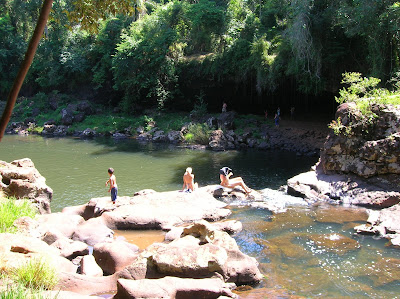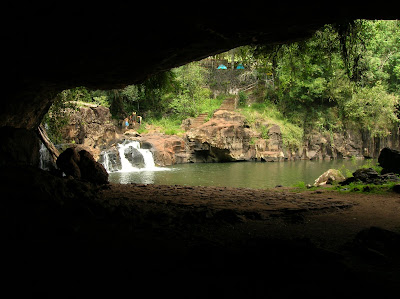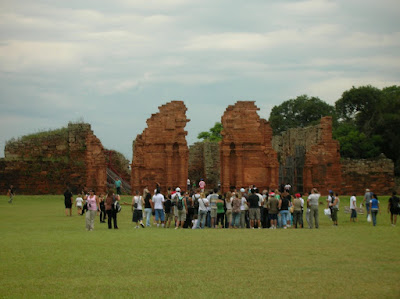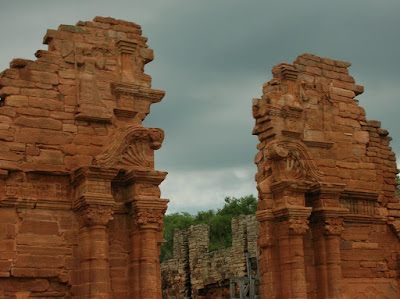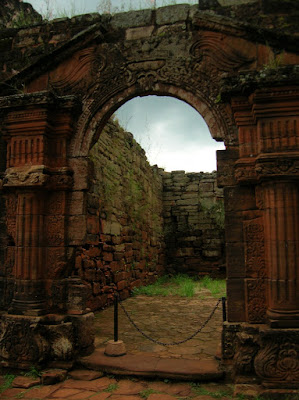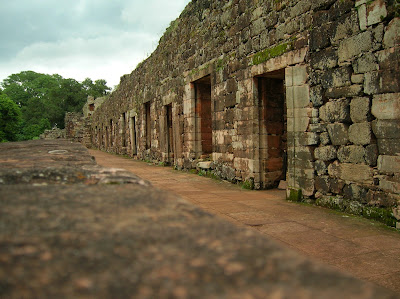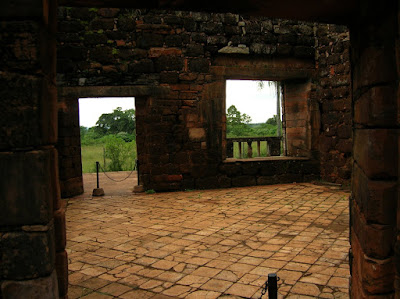After taking a boat to one of the islands we had a nice meal in one of the restaurants overlooking the channel. I must say that the meat served there was by far the tastiest I had so far, but of course I haven't yet visited all the fancy places in Buenos Aires. My mother received a piece of "bife" that was roughly the size (but not the consistency) of a mid-sized brick. We all had huge portions, and we found ourselves in a risky situation of not being able to move due to long digesting process, so took a brave decision and wandered off to walk it out. The island - at least on the map - looked relatively small, with only one path that led us all around it... or that's what we thought. The more we went the harder the terrain looked. It had been raining couple of days before our arrival and the path started to turn muddy. We decided to move on, even though one of the locals warned us that it's probably not the best idea. "What the hell", we thought. "We are not some ordinary tourist people. We can handle it!". That's when the path turned to mud and introduced us to a couple of improvised bridges thrown over smaller channels. They were tricky to cross, because of the 2 cm layers of mud on our shoes or - in some cases - flip flops (the best way to learn is to take the hard way, right?). Every time we had to cross one of those bridges, tension grew higher and higher - it was extremely slippery. After some 45 minutes of walking we were forced to conclude that we it was impossible to continue our joyous hiking - the path was gone. By that time we were all scratched to blood, Niki decided that it's a better idea to walk bare foot and some had the misfortune of crash landing in the mud. Decision had to be taken quickly as the only way to keep mosquitoes away was to walk, so our voluntary guerilla squad turned and headed back. Quickly, it was getting dark. All in all if anyone is wondering how it is to be in the jungle, I advise to do what we did. Of course it's not even close to the real jungle, where you would have to be very lucky to find a path (assuming that it leads somewhere safe), and you would probably have close encounters with considerable numbers of curious animals, wondering if some parts of you are edible. But we'll get back to this subject later.
After our short but exciting visit to Tigre, we spent one more day in Buenos Aires. My father found an old frigate docked in one of the channels in Puerto Madero, and as a old time, die-for fan of everything that floats and has guns, he went to visit it. The next day we were to take off for Puerto Iguazu...
There are a couple of things that I find very strange and controversial about Argentina, I have already written about some of them in my previous posts. This time I will tell you about tourism in this beautiful country. Although in most cases you probably won't encounter this phenomenon, at times, such as flying with Aerolineas Argentinas to a domestic destination, you will be asked to enter your nationality while booking a flight. This, unfortunately, is not for purely statistical or bureaucratic purposes. Argentineans and residents of Argentina enjoy lower prices of plane tickets, while foreigners, which are widely regarded to as "gringos" (even though not all tourists are american..) have to pay more. As an example, Niki, who has her residency, payed about 500 peso (cca. 120 euro), while me and my parents had to pay about 750 (cca. 180 euro). For an European (or gringo) the difference is, perhaps, not that significant. However, keep in mind that 250 peso is enough for one weeks life in Argentina, even if one dines at restaurants everyday. Furthermore, entry to the Iguazu Natural Park is also more expensive for foreigners - 40 peso, while it's 12 peso for an Argentinean or a resident. So keep this in mind while planning a visit to the waterfalls.
The flight was not the most enjoyable I had, with the plane being late and we couldn't get seats next to each other. I was the most unlucky - my seat was at the back of the plane, with no windows and no possibility to lean back, but what the hell - it's just a bit over one hour, and I don't really care for the conditions as long as it takes me where I want to go. Eventually we landed in Puerto Iguazu airport. The air was heavy and it was very hot. We took a taxi to the city and checked into the hostel I have previously reserved. The good thing about traveling with my parents is that they don't care for luxury neither. We booked a simple dorm room with bunk beds, and as there was four of us, we had the room for ourselves. The plan was not to spend most of the time in the room any way. The plan was only to sleep there. The price was around 10 US$ / bed / night, with breakfast included (that is bread, butter, jam and coffee / tea), so all in all it was very cheap. The hostel - Hostel Park Iguazu - is nice and clean, has air conditioning, nice, english speaking staff, and a swimming pool to cool off after running around the jungle all day. We decided to leave our staff and go to the brazilian part of the waterfalls as we were informed that one needs only a few hours to take the trail around it, while for the Argentinean side a whole day is hardly enough. The taxi driver that took us from the airport agreed to take us there for 150 peso, which is actually more than normal, so don't go for it as we did - there are cheaper ways to get there. The only advantage was that he offered to take us to the bird park (Parque de las Aves), wait for us there and then take us to the waterfalls and wait for us there too, so that after it all we could get to Foz de Iguazu, brazilian equivalent of Puerto Iguazu, to eat something. He also tried to persuade us into buying one of the "adventures", as they call the special tourist attractions, like speedboats that take you very close to the waterfalls, but after learning the prices, we decided to skip it, and so I advise to anyone going to the brazilian side - you can do the same on the argentinean side for much less.
Parque de las Aves is a small zoo-type garden dedicated to preservation of rare and not so rare kinds of birds from all over the world, mostly from tropical regions. The entrance fee is about 40 peso, not the cheapest, but not a big tragedy neither. Anyway it's worth to go and see it as it is the first occasion to see rain forest fauna, and all the noisy birds, living in relatively big spaces that allow them to fly more or less freely. I guess the biggest attraction are Tucans, that are really fun, curious birds, that are allowed to wander around the park freely, posing to pictures just as this dude here:
Apart from birds, there is a big collection of water turtles, couple of snakes, crocodiles and a wonderful butterfly cage, where I saw the biggest and most colorful butterflies I have ever seen in my life. In the very same place I also had a chance to see a humming bird (kolibri) for the first time in my life.
They come to feed on flowers or from little containers filled with whatever they like to get high on, and disguised as flowers. I saw one of them from really, really close. They are so small... Like a big bumblebee, really. But definitely my favorite there was this dude (I want to have one):
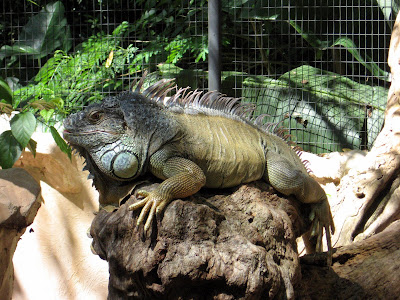
From there we went to the Iguazu Park. The entrance fee to the brazilian side is pretty much the same as on the argentinean one - 40 peso, more or less. There is the park's bus service that take you to various locations in the park, we took it to arrive where the the trail starts and after a couple of minutes it's the first of the many shocks you will experience looking at the falls. It's worth to note, that it's not the biggest one (I men the shock). It's very hot and humid, the air is very heavy and in it you see a mist that comes from water crashing down from over 50 meters. There are over 200 single waterfalls that build up to the breathtaking view of Iguazu Falls. When you have the first encounter it looks something like this:
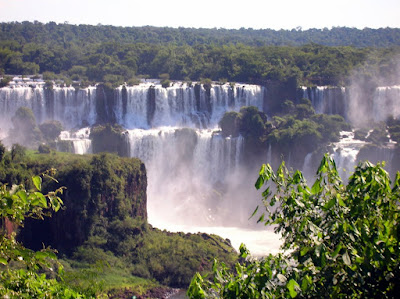
From then on there is a roughly 1,5 km trail leading close to the Devil's Throat, the biggest waterfall of Iguazu, but you don't have a good view of it from the brazilian side. During the walk you get to see many interesting animals that live there, like Iguanas and big hairy spiders. I would say that it's worth to go there, because of the panoramic view of the Falls. Nevertheless, there are a number of impressive locations on the brazilian side, with walking decks build above the mirror of the water so that you can get closer. The sound of crashing water is almost deafening, it really makes you realize the power of the nature. For those who have seen it, there is a great scene in the film "The Mission", when a missionary who failed to win the trust of local Guarani tribe is tied to a cross and let down the river that eventually reaches the Devil's Throat, where the poor guy finds his end in it's roaring waters 70 meters below. Here are a couple of pictures from the brazilian side:
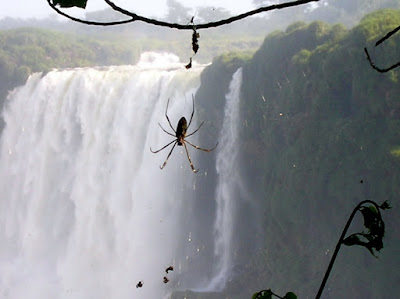
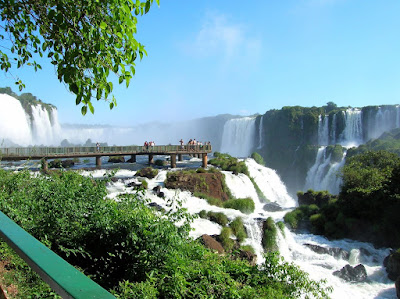

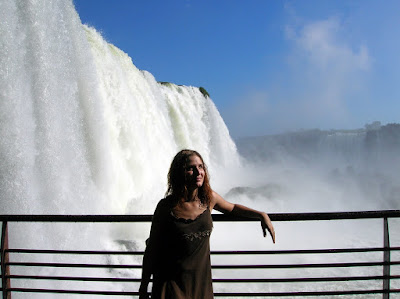
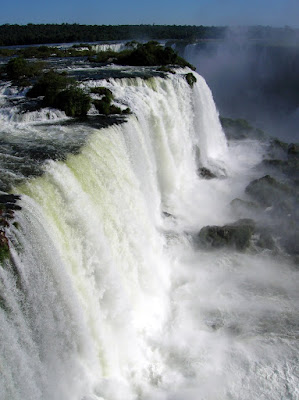
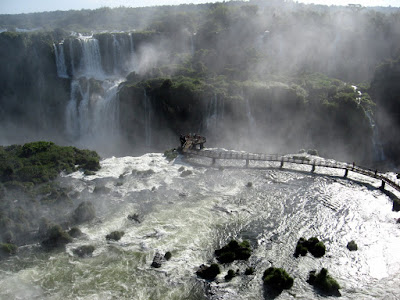
After reaching the end of our trail we took a bus back to the gate of the park, where our beloved taxi driver was waiting for us. He took his chances and decided to persuade us to a dinner in one of the tourist restaurants in Foz de Iguazu. The program consists of local dance shows (I don't think that samba and tango are really local dances there) and a dinner for nothing but 40 US$ per head. No thanks. Suddenly he got sad, realized that he can't squeeze any more cash out of us and started mumbling something about leaving us in Foz de Iguazu, because he didn't feel like waiting for us. What a prick! Sorry man, we're not here to spend our evening in a tourist asylum, and get ripped off; we want something local and authentic! So we got off in the center of the city, which actually doesn't look like center at all, found a bunch of hippies selling bracelets and necklaces who were really nice and showed us where to go to eat something good and cheap. A couple of meters from them there was a simple restaurant, with great food, huge portions, everything cheap, and none of that "feather up my ass" attitude that we would undoubtedly have to cope with on numerous occasions in the future.
From there we took another cab to the argentinean side, consciously bargained the price to a reasonable amount as the cab drivers get a little bit overexcited when seeing foreigners and arrived to our hostel just in time for a nice cold beer, after which we called it a day. Next morning we had to wake up early not to waste time. It was going to be a long day on the argentinean side of the park.
As anticipated we woke up early, had a brief breakfast (only because you can't really play around bread and jam for a long time), went to the city to stock up on empanadas and took a bus to the Falls. Our plan was to first go to the Devil's Throat, then take a 30 min boat with a guide that shows some interesting things about the jungle and some even more interesting animals, and after that, to end the day, take one of the speedboats that come really close to the falls, giving everyone a good shower. One of the differences between the argentinean and brazilian side of the park is that there are no buses on the argentinean side, they have a small train that takes the visitors to various places in the park.
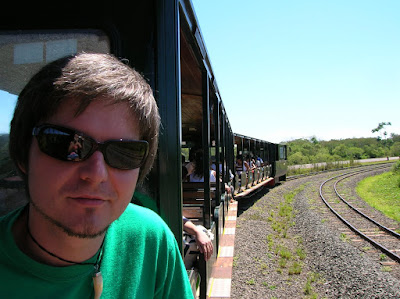
After arriving to the Devil's Throat station, we took a long walking deck built above the river, which leads directly to the edge of the fall. We were lucky to come there after the high season, so there were not so many people, normally it's hard to find a good spot to see anything and you have to wait for a train for hours before it's your turn. As I said, the deck is very long, it takes around 20 minutes to arrive to the showdown, but there are many interesting things to see while walking. For example there is a bunch of friendly butterflies, clearly accustomed to the fact of having people walking forth and back. They often sit on people's hands, apparently feeding on minerals in human sweat. You can walk a good 5 minutes before the butterfly takes off looking for someone else to board.
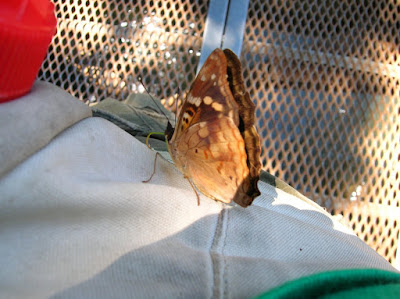
Every now and then, when the deck goes through the trees, there are signs calling for attention as some of the snakes living there may get overly friendly and drop from a tree on your unsuspecting head. It's also worth noting that all the snakes living in this area are venomous. Although their bite is not particularly deadly, I paid good attention in order to avoid their curiosity. Eventually, as we were closing to the destination of our trip, we started hearing a low, humming sound, and we saw that the riverbed suddenly disappears in something that could only be compared to a very large drain, like something that you can find in your kitchen sink. Without any further a do, this is The Devil's Throat:
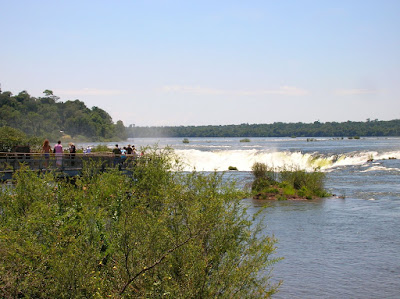

I can tell you one thing for sure: I have never, ever, seen anything like this in my life. The waterfalls, with the water rumbling down cascades, that no leaving creature can survive (except birds, that occasionally dive into this mayhem only to find a moment of refreshing breeze), the jungle that surrounds it, the noise, the hot that seems to stick to every bit of your skin.. It's hypnotic. Every time I stopped to look at the waterfalls, it was something that devoured my attention entirely. One may think that it's just water flowing. But some simply don't realize that it has been flowing like this for millions of years. It's a spectacle of destruction and undeniable beauty. It's a spectacle that keeps on drawing the attention of hundreds of thousands of people who come to see this marvel of nature every year. I felt like I could never leave this place. I felt that I could stand there staring for months, before deciding that my needs for visual feast have finally been satisfied. Every time it seemed that it's enough and we should leave, I felt like coming back and looking and it a little bit more, over and over again. Pictures and videos can't possibly show you what I am talking about. You really have to be there. It's the mother nature saying: "DON'T FUCK WITH ME" and saying it with an echoed voice of billions of drops falling on stones and plants to finally reunite with their own element many, many meters below, where it finally calms down after this loud exclamation, as if having to make this point had cost it a lot of effort, and now it flows freely, throwing gentle reflections on stone walls. Leaving this place somehow filled me with a deep sorrow, I didn't know when would I have a chance to see such a marvel again. But then again, if every moment of our lives was filled with such marvels, we would never learn to appreciate their true value. The only problem that acts to obscure the true dimension of this experience is that all in all it has been brought to nothing more that a tourist attraction - there are thousands of people seeing this place every day, there are bars, and souvenir shops selling T-shirts with logo of the park and it somehow doesn't feel right, but then again I think that not many people would have a chance to see this wonder if it wasn't what it is today. You have to remember that someone, back in the day, has seen it for the first time and told about it to his or her friends who went to see it and passed the story along. The first stone was cast and the avalanche that follows it was just a question of time. I don't think that there are many places of true beauty that are not contaminated with human, invasive presence. It always makes the spectacle a bit less impressive, but there really is no way to avoid it. If someone was to decide not to share a discovery of a place of comparable or greater beauty, it would only be of selfishness.
After satisfying our eyes (to some extent) with the Devil's Throat we returned to the station, next to which a small pontoon dock was situated. That was the beginning of a slow and quite ride on the more peaceful currents of the river, all to discover a bit more about the wildlife of the jungle. Our guide was a young guy from Puerto Iguazu, who lived in the neighborhood all his life. He was really a nice person to be around, partly because he knew so much about all the things that we had no idea about, and partly because he didn't try to make himself look as something better than us - ignorants. He wanted to pass his knowledge to anyone who cared to listen. Luckily there was only us and a couple of other people in the boat, all of which were asking questions about the jungle and the animals living in it. Within five minutes we found ourselves looking at a crocodile 5 meters away from us. She (yes, she) was on the shore, sleeping and guarding her eggs.
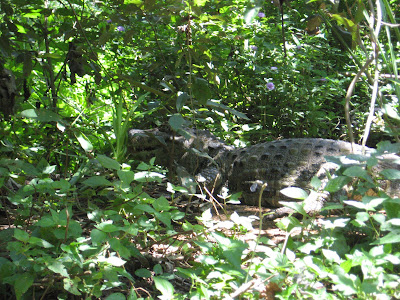
The way we encountered wildlife in the jungle was very cool, because we were on a small rowboat that was making little noise, if any. We never stayed in one place for a long time to make the animals feel endangered, besides they are kind of used to having people come and go every 20 minutes (which sucks). Our guide told us that half an hour before taking on our group he has heard a monkey family in the jungle, perhaps they were still there, so we decided to go and check it out. We didn't find any, but we entered all the narrow corridors made together by the river and the forest to find out what's there - usually a bunch of screaming birds. The guide also told us a story that the area of the park, although normally safe, knows some events, when wild animals showed to the people living there that they can't freely interfere with their territories. Couple of years ago a jaguar kidnapped (and consumed) a baby that was foolishly left by it's parents to play alone in the garden. From his own experience, he has also met a jaguar on his path, without such grim consequences, nevertheless all he could say about the meeting was "he was really big" which proves that you should never neglect wild animals in this region. After the ride, we were transported to the nearest train station from where we could continue our adventure.
The idea was to take the so called "internal trail" that leads to a couple of smaller waterfalls and eventually reach the dock of speedboats that would take us closer to the them. The trail was pretty long and exciting but I will not talk about it too much. One thing worth mentioning are the animals that we spotted on our way. They were funny monkey-like creatures, but unfortunately I already forgot what they're called. One thing I remember is that they were always hungry. If someone was not giving them food, they would climb up, and into, garbage bins and scavenge all the edible stuff they could find. They looked like this:
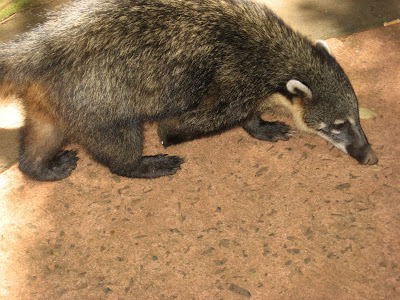
These little bastards are everywhere, and - as usual - all the signs seem to apply only to humans. I mean, there are no signs for those fur-balls saying "don't beg humans for food", but there are signs for us saying, more or less: "don't feed the fur-balls". As with everything, the responsibility for the well being of our planet is in our hands. No surprise here. Anyway, walking the trail we got to see some really beautiful sights, before we eventually got down to the speedboat dock:
That last picture is also the last of the "adventures" that we took. I know it sounds dull, but you know what? I can actually recommend it at the end of the day of watching waterfalls from every possible angle. It just brings you back to life. It's nothing that much special in terms of seeing beauty - no, you won't see any. It's just adrenaline. You will be thrown under a waterfall (a small one mkay? I ain't ready for suicide) and you will be splashed and slashed by the water falling down directly in your face. My advice: bring water goggles. Oh, and listen to the guy who tells you to put all electronic devices in a dry place (that means: a bag) - at the end of the ride you will be wet, soaked, there won't be a single dry spot on you, and yes, that includes your underwear too. All in all a good ride, worth it's money, in my opinion.
After that we walked a little bit and arrived to a nice little bar, where they had beer (no alcohol on the brazilian side - you have been warned!). We took a small rest there, drank a couple and talked how wonderful it would be to live in a place like this, provided that there were no tourists.
The next day was something else again.
/end of part one. wait for what's to follow/
MORE PHOTOS
